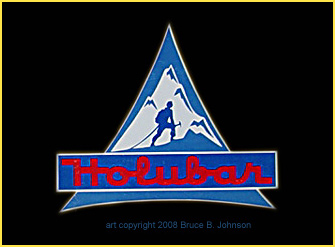

HOLUBAR BOOK: "Holubar
Mountaineering, Ltd.," 96 pages, ISBN 978-1-4276-4391-9,
book cover pictured below. It's a lavishly-illustrated, full-color
8x10 format, available in either a softbound book or a hardbound
book. Recently, I've begun offering the book as a $15 PDF download
directly from me(jupiterman47@gmail.com)....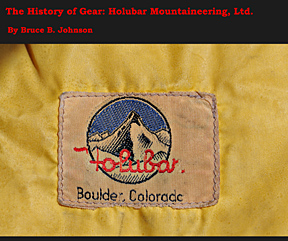 This book was honored as one
of the year's best "Local History" books at Chautauqua
in Boulder, Colorado in 2012, and given a rave review by both
its ex-President and by famous U.S. Gear tester Larry Amkraut....Click
here to go to Book Reviews...For
my discussion of my pricing and quality, click
here....For my Biography as a writer, click
here.
This book was honored as one
of the year's best "Local History" books at Chautauqua
in Boulder, Colorado in 2012, and given a rave review by both
its ex-President and by famous U.S. Gear tester Larry Amkraut....Click
here to go to Book Reviews...For
my discussion of my pricing and quality, click
here....For my Biography as a writer, click
here.
Now, click here, and you will be on Blurb Books, my publisher's website. Here you can preview and purchase either the softbound or hardbound book. For the PDF download version, you will contact me directly (jupiterman47@gmail.com). The price is $15 for the PDF... Autographed books: contact me directly (jupiterman47@gmail.com). Autographed books will cost 10-25% more due to having to ship the book twice.
Also, please take a look at a short and very modernized site that I've recently created that focuses on all six of my books; it's a short alternative to the vast detail offered in my main pages below: see, www.historyofgear.weebly.com
SLACKLINES AND BOULDERING AND SLACK LINES AND SLACK-LINING SPORT.
Other Holubar "New News" -- there's been a rebirth of Holubar. It's based in Italy and has been going for several years, but just this year their products are becoming available in the U.S. The owner, Alberto Raengo, a long-time associate of mine, recently wrote: "Just to inform you that we have begun selling in the USA and Canada in 2016, through a distributor called Triluxe, based in NY and Toronto. They are more into the fashion market but do also sell to the outdoor/sports kind of shops. They think Holubar is great for both market channels. Regards, Alberto Raengo".... Update, Nov. 23, 2001. There's now a list of U.S. shops which are or will be soon, carrying Holubar garments. Milworks in Milwaukie; BackcountryGear; Stars&Strips in Torrance, Calif; and Campsaver (www.campsaver.com)...Soon coming are also Mildblend in Chicago and Josephs in Portland, Maine. NOTE: 2023. ALBERTO is no longer associated with the Holubar compay. I think the new person is Peter Niebolo.
HONORS:
LeRoy and Alice Holubar were given huge honors in 1992 as among the gear industry's twelve "greatest pioneers" - see more here
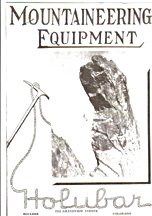 THE
HOLUBARS: Immediately
after World War II, Colorado was a ripe market for a business
targeted to mountaineers and skiers. In Boulder, Colorado, Alice
and Roy Holubar officially opened for business in 1947 by
purchasing a business license.... Roy and Alice had met as Juniors
in High School, and were fellow students at Colorado University
(CU). Roy graduated in 1936 in engineering and taught there until
the demands of Holubar Mountaineering became too great in the
later 1960s. In his youth, Roy had been an active outdoorsman,
primarily hunting and fishing. Click
here to see him in the late 1920s burdened down with an immense
"kidney buster" pack.
THE
HOLUBARS: Immediately
after World War II, Colorado was a ripe market for a business
targeted to mountaineers and skiers. In Boulder, Colorado, Alice
and Roy Holubar officially opened for business in 1947 by
purchasing a business license.... Roy and Alice had met as Juniors
in High School, and were fellow students at Colorado University
(CU). Roy graduated in 1936 in engineering and taught there until
the demands of Holubar Mountaineering became too great in the
later 1960s. In his youth, Roy had been an active outdoorsman,
primarily hunting and fishing. Click
here to see him in the late 1920s burdened down with an immense
"kidney buster" pack.
During the late 1940s, they catered
to the equipment needs of Roy's companions in Colorado Search
and Rescue, and to the needs of the hundreds of 10th Mtn. troops
who had either stayed, been a part of Camp Hale, or migrated to
Colorado after World War II... One climber remembers that in the
late 1950s you'd walk down a walkway at the Holubars' house on
Grandview Ave, go through a gate into the backyard, and enter
the basement via a stairway to find Alice hard at work sewing!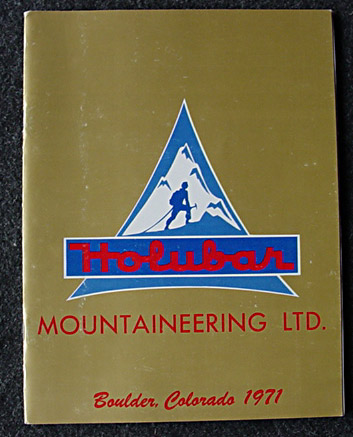
Please Note: All Material in these pages is copyrighted, and no usage of my written or pictorial content is permitted unless explicit permission is granted. Much of the material on this page is derived from interviews and correspondence with ex-Holubar employees.... Others: if you were involved with one of the old-line, vintage gear companies and have a story to tell in these pages, please contact me soon at: jupiterman47@gmail.com -- Sponsors: if your outdoor company is interested in sponsoring this site, please contact me for details. Publishers: my books are published with "POD" technology, which has freedoms but leads to relatively expensive books; thus, The History of Gear Project is seeking a traditional Publisher.
Images: above, the small image in black and white is the front cover of 1950 Holubar catalog, which was Holubar's first catalog. The cover portrays The Maiden, a spire above Boulder in the Flatirons, an early ascent of which Roy had participated in.... To the left, with the big logo, is the cover of the 1971 Holubar catalog. The cover is emblazoned with the "Pryamid" version of the company logo, which first appeared in the '63-64 catalog, and emphasized the company's appeal to mountaineers and climbers.
Holubar Mountaineering co-holds with GERRY Mountaineering the title of the very first of the innovative outlets for modern American-made climbing/camping gear in the United States.... In fact, Jack and Joan Stephenson of Warmlite were inspired personally by the Holubars upon the occasion of their 1955 honeymoon trip to Rocky Mountain National Park in Colorado. The couple had suffered through a cold, miserable trip until Roy and Alice took the youngsters into their Boulder home and "turned them on" to custom down gear of the highest order. The Stephensons returned to California inspired, and began their own "business in a basement" (Warmlite link).
Their influence did not stop with the Stepensons... In 1962 Bob Swanson rolled into Boulder looking for work. GERRY Cunningham did not have work for him, but Bob found welcome with Alice and Roy at Holubar, and worked for them almost a year. Then he moved back to California, where he went to work for Trailwise, met George Marks there, and in 1965 the two of them founded the famous company called Sierra Designs!
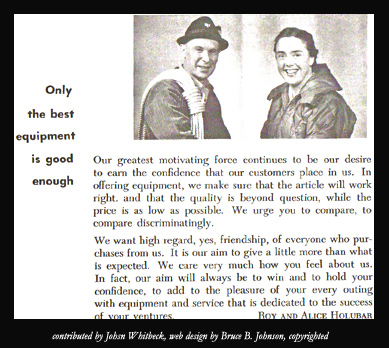 In the Holubar home, Alice, a brillant
woman with a Master's degree in German, was "the brains of
the outfit," according to Lou Barnes (see
below). The image to the left is from the couple's 1950 catalog,
which was their first one......Sometime in the early 1950s, Alice
began to design and sew and sell featherweight sleeping bags that
were quantum leaps ahead of what other American camping firms
were offering. She used the best quality down and enclosed the
fluffy stuff in the cutting-edge modern new shell material called
"nylon," at first a luscious type called "French"
nylon, and later very lightweight 1.5 oz. ripstops... Many detractors
worried that the lightweight new material wouldn't be strong enough,
and others were sure it wouldn't be downproof, but gradually over
the years the detractors became believers, and by the late 60s
everyone was packing sleeping bags made of nyon. At first Alice
sewed with nylon that was war surplus parachute cloth for the
baffling, and luscious "French nylon" for the shells.
In later years she used modern ripstop nylons.
In the Holubar home, Alice, a brillant
woman with a Master's degree in German, was "the brains of
the outfit," according to Lou Barnes (see
below). The image to the left is from the couple's 1950 catalog,
which was their first one......Sometime in the early 1950s, Alice
began to design and sew and sell featherweight sleeping bags that
were quantum leaps ahead of what other American camping firms
were offering. She used the best quality down and enclosed the
fluffy stuff in the cutting-edge modern new shell material called
"nylon," at first a luscious type called "French"
nylon, and later very lightweight 1.5 oz. ripstops... Many detractors
worried that the lightweight new material wouldn't be strong enough,
and others were sure it wouldn't be downproof, but gradually over
the years the detractors became believers, and by the late 60s
everyone was packing sleeping bags made of nyon. At first Alice
sewed with nylon that was war surplus parachute cloth for the
baffling, and luscious "French nylon" for the shells.
In later years she used modern ripstop nylons.
Roy, who was a math professor in the Engineering Department at Colorado University, had gotten a business license in 1947, and had been importing European gear like Molitor brand boots, and many items of climbing hardware; eg. Salewa, Grivel, and Stubai. In those very early times, circa 1950, Roy did not like Goldline rope, and instead supplied his customers, especially Mountain Rescue, with a made-in- America white, laid 3-strand rope named "Columbian."
Author's personal Holubar connections--- as a poor college student in 1972,
it took me a long time to save up enough money for a premium down
bag, but when I finally had enough, the choice was clear, and
I purchased one of Holubar's premium down bags, in a winter weight,
for $137.00. Its 1.2 oz. ripstop nylon shell was a beautiful blue,
and it was so sensuously soft, puffy and WARM that I left it out
unpacked in the living room just to find excuses to feel it on
a daily basis....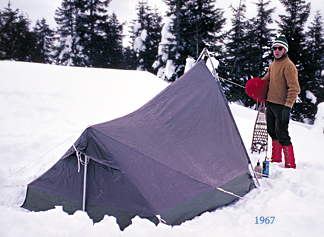 Its
name was "Royalight," which I found out years later
was an acronym for "Roy," "Alice" and "lightweight."
It was the perfect name choice for such a sleeping bag-- it was
very light and it was worth a King's ransom and it was a bag to
treat royalty with, oh, and it was a royal shade of blue to boot......I
miss that bag! Keith Jimmerson (see below)
still fondly owns and uses his Royalight bag, believing it has
lost little of its impressive loft even after 30 years! John Whitbeck
and his wife both still use their Royalight bags year-around.....
Years before the Royalight bag, my very first Holubar product
had been their A-framed Mountain Tent, which was the "Royalight,"
model I (one). It is seen below during a blizzard-plagued snowshoe
trip in 1967. We found the tent to be cramped for two guys in
winter conditions. Although strong, it did not use use modern,
lightweight ripstop nylon in the canopy;
instead it used Holubar's own creation, NP-22 (similar to 60/40
cloth, which came along many years after Holubar began using NP-22)...
The NP-22 created a tent that was somewhat heavy and opaque--
thus the tent was very dark and glum inside at night or during
stormy
conditions...On the plus side, it was not supplied with a
rain fly, which was basically an outdoor
umbrella for the tent, as it was supposedly not needed...Years
later, manufacturers wised-up to the use of cheerful orange and
yellow tent canopies, which helped to prevent "tent fever"
among expeditionary climbers trapped for days at a time in their
tents by severe conditions.
Its
name was "Royalight," which I found out years later
was an acronym for "Roy," "Alice" and "lightweight."
It was the perfect name choice for such a sleeping bag-- it was
very light and it was worth a King's ransom and it was a bag to
treat royalty with, oh, and it was a royal shade of blue to boot......I
miss that bag! Keith Jimmerson (see below)
still fondly owns and uses his Royalight bag, believing it has
lost little of its impressive loft even after 30 years! John Whitbeck
and his wife both still use their Royalight bags year-around.....
Years before the Royalight bag, my very first Holubar product
had been their A-framed Mountain Tent, which was the "Royalight,"
model I (one). It is seen below during a blizzard-plagued snowshoe
trip in 1967. We found the tent to be cramped for two guys in
winter conditions. Although strong, it did not use use modern,
lightweight ripstop nylon in the canopy;
instead it used Holubar's own creation, NP-22 (similar to 60/40
cloth, which came along many years after Holubar began using NP-22)...
The NP-22 created a tent that was somewhat heavy and opaque--
thus the tent was very dark and glum inside at night or during
stormy
conditions...On the plus side, it was not supplied with a
rain fly, which was basically an outdoor
umbrella for the tent, as it was supposedly not needed...Years
later, manufacturers wised-up to the use of cheerful orange and
yellow tent canopies, which helped to prevent "tent fever"
among expeditionary climbers trapped for days at a time in their
tents by severe conditions.
I. VIBRAM SOLES FOR CLIMBING BOOTS--- Look down at your feet next time you go hiking or climbing. Even if you're wearing the new-fangled VFF footwear (Vibram Five Fingers), you have Roy Holubar to thank! During the late 1940s, Roy's determined efforts brought the new European "Bramani" climbing soles (later generically known as "Vibram") to American climbers and hikers. Within a couple years more his lobbying efforts helped convince Goodyear Rubber of America to start manufacturing them. Roy offered a service where you'd send your boots to him, and he'd take them to a Boulder cobbler, then send them back to you with your choice of Vibram sole installed, all for $6 plus shipping! Of course, Roy also imported an elite selection of the best European boots with brands such as Molitor and Kronhofer.
II. 60/40 Cloth vs. NP-22 and Origin
Story of the classic "Mountain Parka"--- Oral history states that Alice was perhaps the
first person in the U.S. to commericially sew and sell garments
made of 60/40 cloth, such as the famed Holubar Mountain Parka;
however, the most reputable insider sources are totally clear
that for some 15 years Holubar used its own innovative fabric,
a nylon-cotton blend, which up until 1961 they called "Everest-type
nylon-pima," and renamed to "NP-22" in their 1961
catalog. It was 50% nylon on the "warp," and 50% pima
cotton on the "weft," with the "NP" probably
standing for "nylon-pima" and the 22 standing for 1/2
nylon and 1/2 cotton. They sold many of the NP-22 parkas to Colorado
Mountain Rescue (Rocky Mountain Rescue Group)... .Image:
NP-22 parka worn by author's relative in 1972, sporting the trademark
optional leather shoulder rappel patch; this orange-ish color
began to be offered in 1970 for the first time.... ...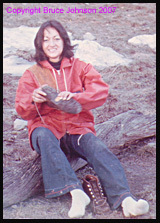 Alice's use of a cotton/nylon blend in a shell parka design pre-dates
the founding of Sierra Designs by over a decade (SD is well-known
as the company which originated THE "60/40 Parka," in
the late 1960s).... Keith J. relates that he donated one of Alice's
early NP-22 mountain parkas to the Neptune
Mountaineering Gear Museum. If you are in the Boulder area,
the extensive gear/climbing museum put together by Gary Neptune
is a true "MUST SEE." --Note: in about 1972-74, the
company shifted to using 65/35 cloth, which they called "Storm
Cloth." Of course their parka was still tailored and sewn
to their insane levels of craftsmanship. Holubar could not have
succeeded without the superb sewing skills and commitment to perfection
of first Alice herself, and then later key sewing personnel such
as Janet Folden (and other names that are included in the book
about Holubar, released late October 2009).
Alice's use of a cotton/nylon blend in a shell parka design pre-dates
the founding of Sierra Designs by over a decade (SD is well-known
as the company which originated THE "60/40 Parka," in
the late 1960s).... Keith J. relates that he donated one of Alice's
early NP-22 mountain parkas to the Neptune
Mountaineering Gear Museum. If you are in the Boulder area,
the extensive gear/climbing museum put together by Gary Neptune
is a true "MUST SEE." --Note: in about 1972-74, the
company shifted to using 65/35 cloth, which they called "Storm
Cloth." Of course their parka was still tailored and sewn
to their insane levels of craftsmanship. Holubar could not have
succeeded without the superb sewing skills and commitment to perfection
of first Alice herself, and then later key sewing personnel such
as Janet Folden (and other names that are included in the book
about Holubar, released late October 2009).
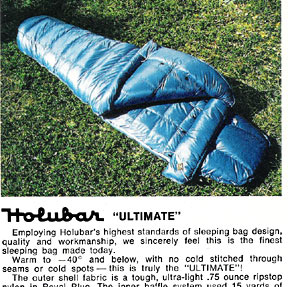 III. Sleeping Bag Design: arguably, Alice Holubar, was one of the very first
people in the USA working in nylon and down, and created designs
and set standards for everybody who was to follow. I give Alice
Holubar the Pioneer Award of: Creator of the first truly modern, lightweight
down sleeping bag in America.".... Among the firsts Holubar can claim are bags
that draped the sleeper in a wonderful warm embrace due to the
use of a purposefully non-differential cut. Alice also perfected
the use of the "V" baffle and longitudinal baffle construction.
Such inner construction, coupled with the innovative down-filled
collar (the "Holubar Collar") made Holubar bags the
preferred choice of many early Himalayan and Alaskan mountaineers
during the 50s and 60s (before most of the big-name Companys like
North Face or Sierra Designs had even opened their doors). An
interesting story in this regard is about the naming of their
down collar, which was called the "Kara Koram collar"
for years, until the use was challenged by Eddie Bauer, who also
had a line of expedition-oriented down gear (click
for more).....Pictured is the Holubar top of the line expeditionary
bag, from their 1975 catalog. This 40-below zero-rated monster
contained 4 lbs. 3 oz. of superb down and is the only bag I have
ever seen that was covered in an ultra-ultra light 0.75 oz. nylon....
In todays dollars, its price seems unbelievably low, a mere $215.00.
At least one company insider states that the Ultimate, and also
the Paragon clothing below were excessively warm for anything
but the most extreme arctic/antarctic/high altitude survival-type
conditions! ... BUT WHAT WAS THE INNOVATION NEEDED FOR LIGHTWEIGHT
GROUND INSULATION? CLICK HERE FOR THE
BRIEF HISTORY OF ENSOLITE.
III. Sleeping Bag Design: arguably, Alice Holubar, was one of the very first
people in the USA working in nylon and down, and created designs
and set standards for everybody who was to follow. I give Alice
Holubar the Pioneer Award of: Creator of the first truly modern, lightweight
down sleeping bag in America.".... Among the firsts Holubar can claim are bags
that draped the sleeper in a wonderful warm embrace due to the
use of a purposefully non-differential cut. Alice also perfected
the use of the "V" baffle and longitudinal baffle construction.
Such inner construction, coupled with the innovative down-filled
collar (the "Holubar Collar") made Holubar bags the
preferred choice of many early Himalayan and Alaskan mountaineers
during the 50s and 60s (before most of the big-name Companys like
North Face or Sierra Designs had even opened their doors). An
interesting story in this regard is about the naming of their
down collar, which was called the "Kara Koram collar"
for years, until the use was challenged by Eddie Bauer, who also
had a line of expedition-oriented down gear (click
for more).....Pictured is the Holubar top of the line expeditionary
bag, from their 1975 catalog. This 40-below zero-rated monster
contained 4 lbs. 3 oz. of superb down and is the only bag I have
ever seen that was covered in an ultra-ultra light 0.75 oz. nylon....
In todays dollars, its price seems unbelievably low, a mere $215.00.
At least one company insider states that the Ultimate, and also
the Paragon clothing below were excessively warm for anything
but the most extreme arctic/antarctic/high altitude survival-type
conditions! ... BUT WHAT WAS THE INNOVATION NEEDED FOR LIGHTWEIGHT
GROUND INSULATION? CLICK HERE FOR THE
BRIEF HISTORY OF ENSOLITE.
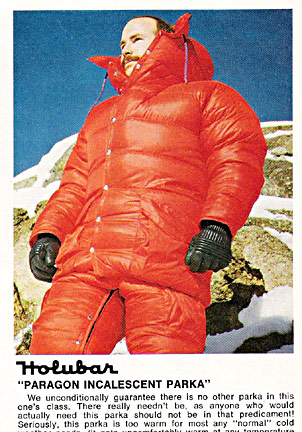 IV.
Down Insulated Clothing: Lou stated strongly, "Holubar Mountaineering,
(was) a Boulder-native specialty retail chain and catalog house
which manufactured possibly the best down-insulated clothing ever
made." He described to me proudly the Holubar "Paragon
Parka," which was a completely V-baffled expedition parka
of the very highest caliber. With the beautiful baffling and a
full 30 oz. of top-quality down, this parka was very popular in
Antarctica, with Himalayan expeditions, and also was ordered by
the military for some of their extreme outposts, such as on the
DEW Line. This image of the Paragon is from the 1975 Holubar catalog,
where this beauty cost only $155.00. You could also purchase a
matching pair of fully V-baffled down pants for $110.00, which
could be zipped into a toasty sleeping bag for your lower half!
IV.
Down Insulated Clothing: Lou stated strongly, "Holubar Mountaineering,
(was) a Boulder-native specialty retail chain and catalog house
which manufactured possibly the best down-insulated clothing ever
made." He described to me proudly the Holubar "Paragon
Parka," which was a completely V-baffled expedition parka
of the very highest caliber. With the beautiful baffling and a
full 30 oz. of top-quality down, this parka was very popular in
Antarctica, with Himalayan expeditions, and also was ordered by
the military for some of their extreme outposts, such as on the
DEW Line. This image of the Paragon is from the 1975 Holubar catalog,
where this beauty cost only $155.00. You could also purchase a
matching pair of fully V-baffled down pants for $110.00, which
could be zipped into a toasty sleeping bag for your lower half!
Many of the Holubar designs are still so popular that when an example comes up on eBay, it gets many bidders and sells for a lot more than it cost when new, 30 years ago! As an example, a pair of ladies down-filled mittens recently sold for $32, with 8 bidders fighting over the privilege of owning them!
By 1979, Holubar had expanded into a chain of ten retail stores, with storefronts in Boulder, Denver, Fort Collins and in Colorado Springs. There were also five out-of-state locatons: Edina, Minnesota; Salt Lake City, Utah; Phoenix, Arizona; Tempe, Arizona; Santa Ana, California, and Glendale, California (click for detail about the Kelty connection). In addition to the stores, Holubar owned a large in-house manufacturing operation, and a huge kit-selling enterprise (Carikit) that had its own catalog (see image on page bottom , taken from 1978 kit catalog). This kit component challenged Frostline, the giant kit company of the times. And of course Holubar had a robust catalog sales division as well, presided over by Byron Evenson......But only a year or two later, Holubar was gone forever.
THE EXIT OF ROY AND ALICE FROM THE BUSINESS----
In a way, the stage had been
set eleven years previously, in 1968. That was when two key events
had occurred. The first led to the second. Alice Holubar contracted
cancer and passed away late in 1968 (Roy continued to live in
their home at 1215 Grandview until his death in 1992)....Earlier
in 1968, because of her condition, Roy and Alice had decided to
travel as much as they could, and that had meant selling the business,
in about March, to an enterprising 25 year old MBA named Jim
Kack from North Dakota (born 1941). 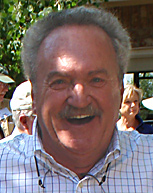 Mr.
Kack wasn't a climber but did enjoy fly fishing and other outdoor
pursuits. The picture of Mr. Kack to the left is from the recent
Holubar Reunion in Boulder, in July 2008 (image compliments of
John Rutkowski).
Mr.
Kack wasn't a climber but did enjoy fly fishing and other outdoor
pursuits. The picture of Mr. Kack to the left is from the recent
Holubar Reunion in Boulder, in July 2008 (image compliments of
John Rutkowski).
Jim Kack was the able businessman whose vision expanded the Company vastly in just a few years, with the able assistance of such key employees as Bob McFetridge and John Whitbeck. Soon Holubar became such an exemplary business success story that by 1974-75 it caught the eye of Johnson Wax ("Pledge" wax, "Off" insect repellant; "Edge" shaving gel, among others). Kack sold Holubar to Johnson Wax at this point. Holubar's new owner was truly a corporate giant with many resources and talents, and it purchased Holubar at the same time it was busy buying up a number of other high-quality outdoor gear companies, eg. Eureka tents; Old Town Canoe, Camp Trails packs, Orvis and Leonard Rod.
Unfortunately, Holubar did not thrive under Johnson Wax, although most seem to agree that it was no one's fault in particular. Huge amounts of effort were expended for about 4 years in trying to find a financially viable direction for the now-struggling company, but the end was nearing when Johnson Wax took semi-truck loads full of Holubar Kits to its Racine, Wisconsin headquarters in about 1980 and sold them out of the back of the trucks for pennies on the dollar. An economic recession was afoot in the U.S., fueling store closings at about the same time. Sometime in 1980, Johnson Wax made the hard decision to close down Holubar's remaining operations.
In a piece of serious irony, Lou Barnes, the ex-merchandising manager for Holubar, had switched careers and was in Boulder in 1980 working as a real-estate person. It was he who managed the sale of the Boulder holdings of Holubar, which included the retail store on 30th Ave., the Administration headquarters on 55th St., the warehouse, and the manufacturing plant. (Note: the original retail location prior to 30th Ave. had been a much smaller place on 13th St., across from Flatirons theater, a block off campus)..... The real estate proceeds went to the Company's corporate owner, Johnson Wax.......
The Pseudo-Holubar Days: The September 1981 "North Face Newsletter"
proudly announced its acquisition of Holubar from Johnson Wax;
Hap Klopp himself signed
the landmark newsletter. The
nine Holubar stores in three States, the Holubar name, and all
the inventory became North Face's... 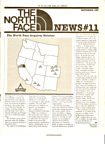 Greg
Grant remembers how The North Face swiftly established itself
at the 30th Ave. main store in Boulder, but left all the Holubar
signs in place (30th Ave. was the original Holubar store, and
had originally also contained both headquarters and the sewing
operation). Sometime in 1981, a planned shopping mall forced the
closure of the original store, and pseudo-Holubar moved to South
Broadway St., and was still using the Holubar name in 1983 when
Greg left. ....Greg said, "We would receive North Face payroll
checks, but our signs all said Holubar....no one would have known
we were owned by the North Face unless we told them." This
pseudo Holubar at first was selling many brand names,including
actual old Holubar-made inventory, but later "Holubar"
labelled garments were really being made by North Face in Berkeley,
but in gradually diminishing numbers. It remains unclear at this
point in my research exactly when "Holubar" labelled
gear stopped being manufactured and sold by North Face. Eventually,
though, the Holubar name seems to have been let to die by North
Face. (The North Face itself was later absorbed by a major corporation,
click here for details about
its fate)
Greg
Grant remembers how The North Face swiftly established itself
at the 30th Ave. main store in Boulder, but left all the Holubar
signs in place (30th Ave. was the original Holubar store, and
had originally also contained both headquarters and the sewing
operation). Sometime in 1981, a planned shopping mall forced the
closure of the original store, and pseudo-Holubar moved to South
Broadway St., and was still using the Holubar name in 1983 when
Greg left. ....Greg said, "We would receive North Face payroll
checks, but our signs all said Holubar....no one would have known
we were owned by the North Face unless we told them." This
pseudo Holubar at first was selling many brand names,including
actual old Holubar-made inventory, but later "Holubar"
labelled garments were really being made by North Face in Berkeley,
but in gradually diminishing numbers. It remains unclear at this
point in my research exactly when "Holubar" labelled
gear stopped being manufactured and sold by North Face. Eventually,
though, the Holubar name seems to have been let to die by North
Face. (The North Face itself was later absorbed by a major corporation,
click here for details about
its fate)
But former Colorado Springs Manager Bob Clemen has a final Holubar report, "One interesting twist -- when I was back in Colorado Springs in 1990 for a High School Reunion, I discovered that a couple of people had resurrected and licensed the old original Holubar logo, and they had opened a Holubar store in one of the shopping centers there. No relation to the previous company except for the name and the logo. I have no idea if the store is still there." As a sidenote to this story, I will note that the Colorado government site that lists businesses and their registered names has NO listings for "Holubar," and those listings generally go back at least 15-20 years, so we can conclude sadly that "Holubar" as an official business name in Colorado is no more.
R.I.P. Holubar, 1947 to 1980, or shall we count the pseudo-Holubar as the real deal? In which case it becomes R.I.P. Holubar, 1947 to November 21,1985, when the Boulder Daily Camera newspaper announced that the "Holubar" sign on the Boulder store was coming down and being replaced by "The North Face" signs... Some might think the "Thanksgiving" timing was in poor taste!.....But then again, maybe the ghost of Holubar is still alive and about to open a store somewhere in Colorado! You decide!
But Holubar is too good a brand to just die forever. In 2008-09 I began to work with Alberto Raengo at his Italian clothing company (Fritz s.r.l.) seeking to bring back the heritage of a great American outdoor brand. Based in Northern Italy in the city of Pordenone, they chose Holubar.... Fall 2018 will be their fifth season of exciting Holubar-labelled jackets and parkas, all with the love of the Holubar tradition modified for the fashion consciousness of Italians and other Europeans. See their website at www.Holubar.it (it's in Italian, but you can view the jacket styles; don't miss the selection of about 50 pictures that show most of the classic Holubar catalog covers, as well as selected pages therefrom!). There is also a Facebook page for Alberto Raengo's Holubar, found under the name of "Holubar - Since 1947." (Beware: there are several other Facebook pages calling themselves Holubar, but only one is the Italian Holubar that owns the brandname and is currently producing Holubar garments)
CONTRIBUTORS: Lou Barnes described to me many of the Holubar "firsts," and he should know. Lou is the former Merchandising Manager for Holubar, and was with the Company from 1973 to 1978. While Lou was with the Company, he scored several industry-wide firsts in design and product mix. A second contributor has been Bob Clemen, who worked several Holubar stores between 1976 and 1980, ending up managing the Colorado Springs store under Bob Peto. A third contributor has been Greg Grant, who knew Roy Holubar; Greg worked under John Whitbeck in the Boulder store, 1979-80, and went on to work from 1980-83 in the pseudo-Holubar store in Boulder that was really owned by The North Face! (see below). A fourth contributor has been Keith Jimmerson, who worked in the Denver store on Exposition from about 1969 through 1978. John Whitbeck has also been a contributor; John had managed the Boulder GERRY store on Pearl St, and then was hired by Jim Kack in late 1968, after Alice Holubar's death; this was soon after Roy and Alice had sold the company to Jim Kack (see below). Most recently, I have spoken with Charlie Lincoln, who joined Holubar in 1973 and had risen to General Manager before North Face's take-over in the late 1970s. Even more recently, I have spoken with John Rutkowski, who was Store Manager at the Salt Lake City store, and later at the Glendale, CA store when Holubar bought the Kelty store there. After Holubar closed down its factory, John began Mountain Mend in Boulder, and did Holubar warranty work. Interestingly, he and Charlie got together at this time and sewed up the last dozen Ultimate bags (see image below); they used the nylon shells found when the factory closed down.
 Gerry
Cunningham (click for two full pages about GERRY) This innovator and climber also lived
in the Boulder area. He was one of the very early pioneers, and
founded his company in 1946, the same year as Holubar Mountaineering.......
Gerry C. was a veteran of WW II and was 84 years old when I established
contact with him in 2006. Notes: "GERRY" is a
well-known brand which continued to produce gear, mostly clothing
for skiers, for many decades after Mr. Cunningham left the company
in 1971. Recent Labels such as those on the left claim that the
Company's location is in Seattle; the explanation of course is
that GERRY (the company) was long ago absorbed by a big corporation.
Gerry
Cunningham (click for two full pages about GERRY) This innovator and climber also lived
in the Boulder area. He was one of the very early pioneers, and
founded his company in 1946, the same year as Holubar Mountaineering.......
Gerry C. was a veteran of WW II and was 84 years old when I established
contact with him in 2006. Notes: "GERRY" is a
well-known brand which continued to produce gear, mostly clothing
for skiers, for many decades after Mr. Cunningham left the company
in 1971. Recent Labels such as those on the left claim that the
Company's location is in Seattle; the explanation of course is
that GERRY (the company) was long ago absorbed by a big corporation.
Please Note: All Material above, and in all my "History
of Gear" webpages, is copyrighted, and no usage of my material
is permitted unless explicit permission is granted by me, Bruce
B. Johnson, owner of OregonPhotos.com. Some of the material above
is derived from interviews and correspondence with ex-Holubar
employees.... Editors: Please contact me at
jupiterman47@gmail.com. if you have interest in publishing....Others: if you were involved with one of the
old-line, vintage gear companies and have a story to tell in these
pages, please contact me soon.
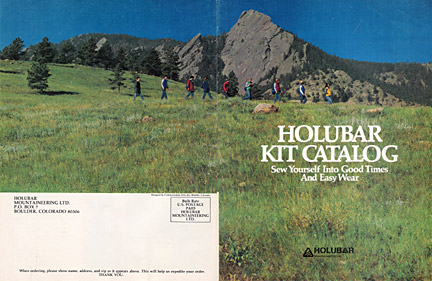
Holubar Kits, aka "Carikits."
To the left is an image showing the complete front and back cover of the 1978 Holubar Mountaineering Ltd. Kit catalog. Prominent on the skyline are Boulder's famous "Flatirons," a climbing/hiking mecca right in the backyard of the Holubar offices/stores in Boulder. The string of hikers are all Holubar employees! Can anyone identify any of these folks?
Historical Detail: Holubar/Kelty/Camp Trails. During the mid-late 1970s, Holubar's Jim Kack/Johnson Wax and Kelty's Dick Kelty were carrying selected products in each other's retail stores. Camp Trails packs were part of this mix, too, through the ownership of Johnson Wax. As Kelty grew larger, its stores, and Camp Trails' stores, moved into Holubar management, eg. Kelty's Glendale location and Camp Trails' Phoenix location. Thus, when the end came for Holubar, it had some out-of-State stores under its management that also needed to be closed down.
THE HISTORY OF GROUND INSULATION: ENSOLITE. Trademark definition by the United States Rubber Company was this: "[A] cellular plastic material in sheet form resembling sponge rubber." Ensolite was an innovation in gear that gave early backpackers a much better option for cold weather and compactness than previous open cell foam pads or air mattresses....The Ensolite trademark application was in 1950, granted in 1953, TM # is 71599723.... However, my tracking of ground insulation options in the early catalogs of the major gear companies revealed that Ensolite does not seem to have entered distribution to the backpacking public until sometime between 1965 and 1969. By the 1973 EMS catalog, several varieties of it were listed including references to a new, better version of it named "Volarfoam" in 1970. I recall using Ensolite Type M for several years in the time frame of 1968-1975, usually in the 3/8 inch thickness, but sometimes in the 1/4 inch for summer or 1/2 inch for winter use.